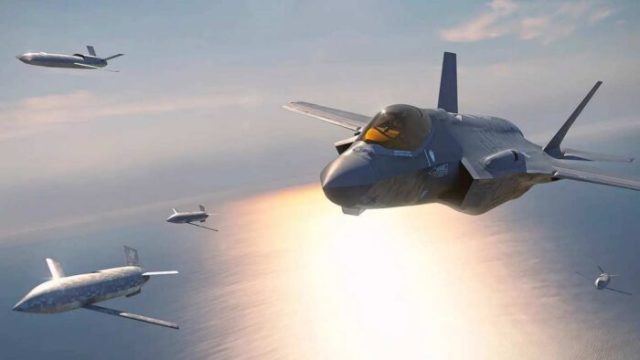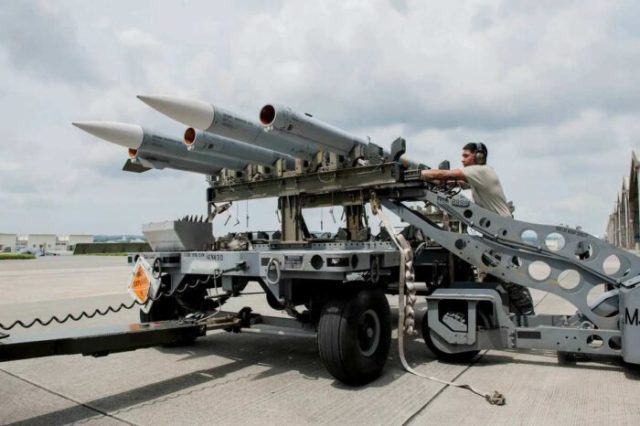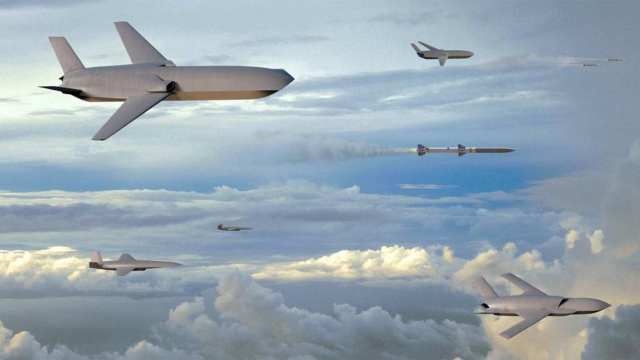The US Air Force announced the laying of the foundation for the accelerated production of the future unified improved tactical missile AIM-260, or JATM (Joint Advanced Tactical Missile). In part, this is done to ensure the availability of a sufficient number of such air-to-air missiles, which are also intended to arm future fleets of unmanned aerial vehicles (UAVs) with a high degree of autonomy.
Such UAVs are called Collaborative Combat Aircraft (CCA), or "loyal wingmen" . It is believed that UAVs armed with these missiles will work closely with combat jets of the current and next generations and will be able to significantly expand the range, increase the combat effectiveness and survivability of their manned colleagues.
As stated earlier, in the current 2023, Air Force Secretary Frank Kendall (Frank Kendall), his service plans to purchase at least 1,000 CCA (if not more), as well as about 200 samples of a promising sixth-generation combat jet . Both of these programs are part of a larger, multifaceted effort to create a tactical air dominance aircraft, or NGAD (Next Generation Air Dominance). The figure of 1000 CCA is based on the concept of operations involving the pairing of two such drones with each of the 200 combat NGAD and 300 F-35A Joint Strike fighters.

An F-35 fighter jet that interacts with several types of UAVs Detailed information about the AIM-260, including its expected capabilities and delivery dates to the armed forces, is limited.
The Air Force revealed the existence of the JATM program, which they launched together with the US Navy in 2019. At the time, the service said it expected the initial flight tests of the rocket to be completed in 2021, and operational tests to begin sometime in 2022. Last year, Air Force Major J. Kevin AUTRY, the lead test pilot of the F-22 Raptor of the 422nd Test and Evaluation Squadron at Nellis Air Force Base in Nevada, said that preparations are underway for the start of live firing tests in the summer of 2023. Speaking at the round table in April 2023, Lieutenant General Richard Moore insisted that there were no delays in the JATM program.
Otherwise, the development of the rocket is shrouded in the strictest secrecy within the framework of the so-called special access program (SAP). This weapon is so sensitive that in fiscal year 2020, the Air Force requested about $6.5 million to build a special secure storage facility for it at Hill Air Force Base in Utah.
According to open sources, the main focus of the JATM program is a significant increase in the firing range of the missile. It is assumed that the JATM is based on the latest version of the AIM-120D-3 AMRAAM, the range of which is classified, but it is believed that it ranges from 75 to 100 miles (120-160 km), depending on the launch conditions and other factors.

Preparation of AIM-120 AMRAAM missiles for installation on F-15 fighters Earlier, US Air Force officials stated that Chinese developments in the field of long-range air-to-air missiles, in particular the PL-15 missile, which can have a firing range of up to 124 miles (about 200 km), were the key driving incentives for work on the AIM-260.
Which advanced JATM powerplant will be used to achieve such a range has not yet been disclosed, but ramjet and two-pulse rocket engines were offered as possible options. [...]
It seems very likely that the AIM-260 may have a multi-mode homing system, possibly including an active radar and infrared homing devices. This would increase their accuracy and resistance to radio frequency electronic warfare attacks and other countermeasures. The ability to target anything other than a radar signature would be especially useful for hitting low-profile (stealthy) targets.
Given the increased firing range of the missile, it seems almost certain that the JATM will receive a two-way data link, like the AIM-120D-3. Such a channel allows weapons in flight to receive updates on targeting or redirect them completely.
It is expected that all this equipment will fit inside the AIM-260 rocket, which has a similar, if not identical, form factor with later-generation AIM-120 variants. This is extremely important to ensure the possibility of their internal use by the F-22 Raptor fighters of the Air Force, as well as variants of the F-35 in the US Armed Forces.
The F-22 is expected to be the first aircraft armed with the AIM-260. It is also planned to integrate the missile into all three variants of the F-35, as well as into the F-15EX Eagle II fighters of the Air Force and the F/A-18E/F Super Hornet of the US Navy.
Based on the materials of the-war-zone resource

